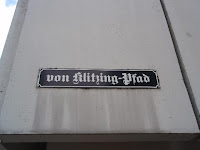We were on another transfer again, but this time the destination was Stuttgart. We were going to visit the International Max Planck Research School (IMPRS) for Advanced Materials. The place was quite far from our hotel, but we had Ms. Nitia as our schedule planner, there was nothing to be worry about. When we arrived, Dr. Hans-George Libuda was already there at our meeting point to welcome us. I was attracted by a road sign, which later I found out it was Prof. Dr. von Klitzing’s students who put it there and named the road as von Klitzing path. (I am sure that Prof. Dr. von Klitzing was happy at that time.) The people from IMPRS were very generous, after we met with the Dr. H. G. Libuda, we were escorted to the canteen and treated a very good meal. (Finally, a complete lunch.)
I wish someday I have my own path.
Here we are, IMPRS for Advanced Materials.
Dr. H. G. Libuda on the right.
Liquid Helium, colder than Everest.
The first part of the laboratory tour was related to the phase transformation and kinetics research. Many complicated machine was introduced and I was pretty amazed by the amount of scientific equipments they have in the Institute.
One word, complicated.
I thought that was all about the equipments they have, but I was wrong. We were later brought to another section of the laboratory tour, the Stuttgart Center for Electron Microscopy. I actually lost count the TEM they have in the institute. (Why are there so many TEM? How the government funded all these Max Planck Institute around Germany?) There was one huge TEM that occupied two floors (yes, floor not room.) and that was another high resolution TEM with its own name SESAM (Sub-Electron-Volt-Sub-Angstrom-Microscope).
You need two floors for this TEM.
SESAM.
Finally, we reached the Prof. von Klitzing’s research group, it was about graphene. Graphene is a one-atom-thick sheet of carbon, the graduate students showed us the materials and how the one-atom-thick sheet of carbon was made and investigated. (It was primitive, really surprised.) Since I had listened to Prof. von Klitzing’s lecture earlier, the practical experience let me understood more and faster.
(Side note: this is a very good experience because it is like a continuation to the Lindau meeting; we could have some hands-on experience in Prof. Klaus von Klitzing's laboratory after his lecture earlier in the meeting.)
Prof. von Klitzing’s graduate students.
It was evening again, and time to planned for dinner. I missed the Nordsee we had in Lindau but found one here in Stuttgart. I bought the fried box, and it was so delicious. While enjoying my dinner, I was browsing the beautiful scenery of this city. What a day.
Street view.
Awesome city of Stuttgart.











没有评论:
发表评论